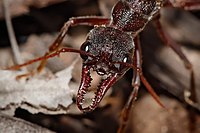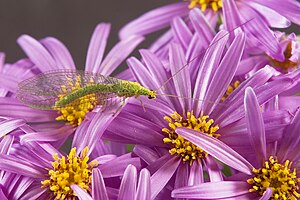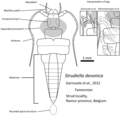The Insects Portal


Insects (from Latin insectum) are hexapod invertebrates of the class Insecta. They are the largest group within the arthropod phylum. Insects have a chitinous exoskeleton, a three-part body (head, thorax and abdomen), three pairs of jointed legs, compound eyes, and a pair of antennae. Insects are the most diverse group of animals, with more than a million described species; they represent more than half of all animal species. (Full article...)
Selected article -

The list of Odonata species of Slovenia includes 72 species of dragonflies and damselflies (Slovene: kačji pastirji) for which reliable records exist from the present-day territory of Slovenia, including one that has not been seen since the 1960s and is presumed to have been extirpated (locally extinct), but could have simply been overlooked. The list is based on two reference works: Atlas of the Dragonflies (Odonata) of Slovenia, a joint publication of the Slovene Odonatological Society and the Slovene Centre for Cartography of Fauna and Flora from 1997, and the newer Atlas of the European dragonflies and damselflies (2015), supported by other, more recent publications in which new species described after 1997 were documented.
Odonata species from the territory of present-day Slovenia were systematically studied by the naturalists Johann Weikhard von Valvasor and Giovanni Antonio Scopoli as early as the 17th and 18th centuries; however, the first systematic compendium was only published in the 1960s by the Slovene zoologist Boštjan Kiauta. The distribution of Odonata in Slovenia is now fairly well known by international standards, with Slovenia having been one of the first European countries for which a full account of faunistic data (an "atlas") was published. The number of species (72) represents almost exactly half of the European species (143) and is comparable with the number of species of Germany (81) and Spain (80), both much larger countries. Slovenian odonate fauna is therefore considered highly diverse, which is attributed to the country's position on the junction of several ecoregions where many species reach the border of their distribution. (Full article...)Did you know -
- ... that the extinct rove beetle genus Ektatotricha is known from 15 beetles trapped in Cretaceous amber from Myanmar?
- ... that "Sheridan's Green Hairstreak", Callophrys sheridanii, is Wyoming's state butterfly?
- ... that one species of the extinct wasp Palaeovespa fed caterpillars to its larvae?
- ... that fighting crickets are provided with female company before the fight, stimulated with tickling during the fight, and buried in silver coffins after it?
- ... that the predatory insect Orius insidiosus is mass-reared for use in the biological control of thrips?
List articles
Related portals
General images -
Selected image -

Green lacewings (Neuroptera: Chrysopidae) is a family of lacewings containing about 85 genera and (according to different sources) 1,300–2,000 species. Members of the genera Chrysopa (pictured) and Chrysoperla are very common in North America and Europe; they are very similar and many of their species have been moved from one genus to the other times and again.
WikiProjects

Main WikiProject:
Related projects:
- WikiProject Arthropods
- WikiProject Spiders
- WikiProject Animals
- WikiProject Tree of Life
- WikiProject Biology
Daughter projects:
Tasks
 |
Here are some tasks awaiting attention:
|
Associated Wikimedia
The following Wikimedia Foundation sister projects provide more on this subject:
-
Commons
Free media repository -
Wikibooks
Free textbooks and manuals -
Wikidata
Free knowledge base -
Wikinews
Free-content news -
Wikiquote
Collection of quotations -
Wikisource
Free-content library -
Wikiversity
Free learning tools -
Wiktionary
Dictionary and thesaurus


















































